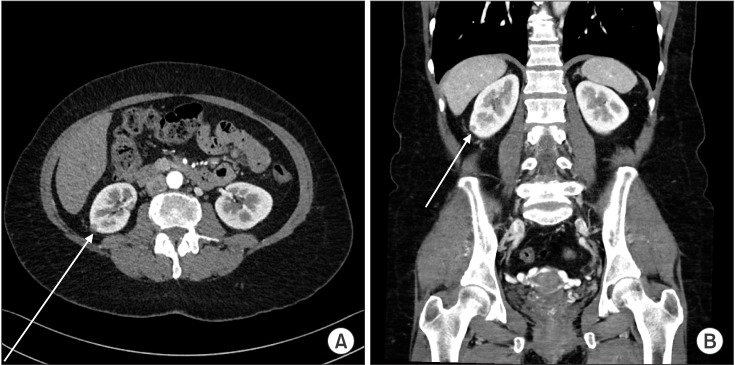Ann Surg Treat Res.
2017 May;92(5):361-364. 10.4174/astr.2017.92.5.361.
Experiences of renal transplants from donors with renal cell carcinoma after ex vivo partial nephrectomy
- Affiliations
-
- 1Department of Internal Medicine, Korea University Medical College, Seoul, Korea.
- 2Department of Surgery, Korea University Medical College, Seoul, Korea. cwjung@korea.ac.kr
- KMID: 2377707
- DOI: http://doi.org/10.4174/astr.2017.92.5.361
Abstract
- PURPOSE
Routine evaluation of kidney donors occasionally reveals an incidental renal mass with an otherwise satisfactory kidney function. The use of such a kidney with an enhancing mass for transplantation is a matter of debate owing to a possible risk of transmission of donor malignancies. We report our experience of kidney transplants from donors with renal cell carcinoma, after ex vivo resection of the renal mass.
METHODS
Two women aged 44 and 56 years were diagnosed with enhancing renal masses measuring 0.9 cm and 0.7 cm, respectively, during donor evaluation for kidney transplantation. Both patients and their families were informed of a potential risk of recurrent renal cell carcinoma following transplantation.
RESULTS
Renal function test results of both donors satisfied the living donor selection criteria. Laparoscopic live donor nephrectomy was performed with ex vivo resection of renal masses on the bench table. Immediate pathological analysis revealed a renal cell carcinoma with a margin of normal renal parenchyma before transplantation. Regimens based on mammalian target of rapamycin inhibitors, which are known for their antitumoral properties, were used for immunosuppression in both recipients. None of the recipients showed recurrence or metastasis during the follow-up period, which was longer than 3 years after transplantation.
CONCLUSION
In light of the ongoing shortage of kidney donors, kidneys with small renal cell carcinoma could be considered for transplantation after appropriate removal of the lesion, with a very low risk of recurrent disease.
MeSH Terms
Figure
Reference
-
1. Johnson DW, Herzig K, Purdie D, Brown AM, Rigby RJ, Nicol DL, et al. A comparison of the effects of dialysis and renal transplantation on the survival of older uremic patients. Transplantation. 2000; 69:794–799. PMID: 10755528.
Article2. Audard V, Matignon M, Dahan K, Lang P, Grimbert P. Renal transplantation from extended criteria cadaveric donors: problems and perspectives overview. Transpl Int. 2008; 21:11–17. PMID: 17850235.
Article3. Rabbat CG, Thorpe KE, Russell JD, Churchill DN. Comparison of mortality risk for dialysis patients and cadaveric first renal transplant recipients in Ontario, Canada. J Am Soc Nephrol. 2000; 11:917–922. PMID: 10770970.
Article4. Becker F, Siemer S, Humke U, Hack M, Ziegler M, Stockle M. Elective nephron sparing surgery should become standard treatment for small unilateral renal cell carcinoma: Long-term survival data of 216 patients. Eur Urol. 2006; 49:308–313. PMID: 16359779.
Article5. Nalesnik MA, Woodle ES, Dimaio JM, Vasudev B, Teperman LW, Covington S, et al. Donor-transmitted malignancies in organ transplantation: assessment of clinical risk. Am J Transplant. 2011; 11:1140–1147. PMID: 21645251.
Article6. Nicol D. Issues in the diagnosis of renal cell carcinoma. BJU Int. 2000; 86:298–303. PMID: 10930936.
Article7. Crepel M, Jeldres C, Sun M, Lughezzani G, Isbarn H, Alasker A, et al. A population-based comparison of cancer-control rates between radical and partial nephrectomy for T1A renal cell carcinoma. Urology. 2010; 76:883–888. PMID: 20932408.
Article8. Dulabon LM, Lowrance WT, Russo P, Huang WC. Trends in renal tumor surgery delivery within the United States. Cancer. 2010; 116:2316–2321. PMID: 20225227.
Article9. Van Poppel H. Efficacy and safety of nephron-sparing surgery. Int J Urol. 2010; 17:314–326. PMID: 20409229.
Article10. Kim JY, Ruckle HC, Ramin SA. Partial nephrectomy for renal cell carcinoma in an allograft kidney 15 years after transplantation. J Urol. 2001; 165:1205. PMID: 11257674.
Article11. Lamb GW, Baxter GM, Rodger RS, Aitchison M. Partial nephrectomy used to treat renal cell carcinoma arising in a live donor transplant kidney. Urol Res. 2004; 32:89–92. PMID: 15250100.
Article12. Neipp M, Schwarz A, Pertschy S, Klempnauer J, Becker T. Accidental transplantation of a kidney with a cystic renal cell carcinoma following living donation: management and 1 yr follow-up. Clin Transplant. 2006; 20:147–150. PMID: 16640518.
Article13. Thomalla JV. Renal cell carcinoma in a renal allograft successful treatment with 5 year follow-up. Clin Med Res. 2004; 2:151–153. PMID: 15931351.
Article14. Nicol DL, Preston JM, Wall DR, Griffin AD, Campbell SB, Isbel NM, et al. Kidneys from patients with small renal tumours: a novel source of kidneys for transplantation. BJU Int. 2008; 102:188–192. PMID: 18435810.
Article15. Ljungberg B, Bensalah K, Canfield S, Dabestani S, Hofmann F, Hora M, et al. EAU guidelines on renal cell carcinoma: 2014 update. Eur Urol. 2015; 67:913–924. PMID: 25616710.
Article16. Mannami M, Mannami R, Mitsuhata N, Nishi M, Tsutsumi Y, Nanba K, et al. Last resort for renal transplant recipients, ‘restored kidneys’ from living donors/patients. Am J Transplant. 2008; 8:811–818. PMID: 18318781.
Article17. Grulich AE, van Leeuwen MT, Falster MO, Vajdic CM. Incidence of cancers in people with HIV/AIDS compared with immuno-suppressed transplant recipients: a metaanalysis. Lancet. 2007; 370:59–67. PMID: 17617273.
Article18. Russ GR. Optimising the use of mTOR inhibitors in renal transplantation. Transplant Res. 2013; 2(Suppl 1):S4. PMID: 24565283.
Article
- Full Text Links
- Actions
-
Cited
- CITED
-
- Close
- Share
- Similar articles
-
- Percutaneous Embolization of Renal Artery Pseudoaneurysm after Laparoscopic Partial Nephrectomy for Renal Cell Carcinoma
- The Treatment Outcomes of a Partial Nephrectomy in the Management of Renal Cell Carcinomas
- A Case of Renal Cell Carcinoma with Hyperglycemia Corrected after Radical Nephrectomy
- A Case of Multilocular Cystic Renal Cell Carcinoma
- Bilateral Synchronous Multifocal Renal Cell Carcinoma


